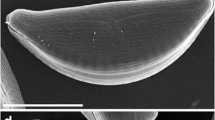Summary
In two species of the diatom genusMelosira the inner profile of the silicalemma fuses with the plasmalemma covering the “older” part of the cell at, or slightly before, maturity of the new siliceous cell wall component. Subsequently, the outer profile of the silicalemma and the remainder of the plasmalemma are cut off. Though there are indications that the valves may continue to add silica after this time the wall component now lies to the outside of a membrane which must,de facto, be considered the plasmalemma. When cingula move apart as development continues the membrane fragments are allowed to disperse and it is thought unlikely that they contribute to the formation of an organic investment of the siliceous components of the frustule.
Similar content being viewed by others
References
Chiappino, M. L., Volcani, B. E., 1977: Studies on the biochemistry and fine structure of silica shell formation in diatoms. VII. Sequential cell wall development in the pennateNavicula pelliculosa. Protoplasma93, 205–221.
Crawford, R. M., 1971: The fine structure of the frustule ofMelosira varians C. A. Agardh. Brit. phycol. J.6, 175–186.
—, 1973: The organic component of the cell wall of the marine diatomMelosira nummuloides (Dillw.) C. Ag. Brit. phycol. J.8, 257–266.
—, 1974: The auxospore wall of the marine diatomMelosira nummuloides (Dillw.) C. Ag. and related species. Brit. phycol. J.9, 9–20.
Dawson, P. A., 1973: Observations on the structure of some forms ofGomphonema parvulum Kütz. III. Frustule formation. J. Phycol.9, 353–365.
Lewin, J. C., 1961: The dissolution of silica from diatom cell walls. Geochim. cosmochim. Acta21, 182–198.
Pickett-Heaps, J. D., Tippit, D. H., Andreozzi, J. A., 1979: Cell division in the pennate diatomPinnularia IV-valve morphogenesis. Biol. cellulaire35, 199–206.
Reimann, B. E. F., Lewin, J. C., Volcani, B. E., 1966: Studies on the biochemistry and fine structure of silica shell formation in diatoms. II. The structure of the cell wall ofNavicula pelliculosa (Bréb.) Hilse. J. Phycol.2, 74–84.
Schmid, A. M. M., Schulz, D., 1979: Wall morphogenesis in diatoms: Deposition of silica by cytoplasmic vesicles. Protoplasma100, 267–288.
Stoermer, E. F., Pankratz, H. S., Bowen, C. C., 1965: Fine structure of the diatomAmphipleura pellucida. II. Cytoplasmic fine structure and frustule formation. Amer. J. Bot.52, 1067–1078.
Stosch, H. A.von, in press: Structural and histochemical observations on the organic layers of the diatom cell wall. Proc. 6th Symp. Recent and Fossil Diatoms, Budapest, Koeltz, Koenigstein.
Author information
Authors and Affiliations
Rights and permissions
About this article
Cite this article
Crawford, R.M. Valve formation in diatoms and the fate of the silicalemma and plasmalemma. Protoplasma 106, 157–166 (1981). https://doi.org/10.1007/BF02115969
Received:
Accepted:
Issue Date:
DOI: https://doi.org/10.1007/BF02115969




